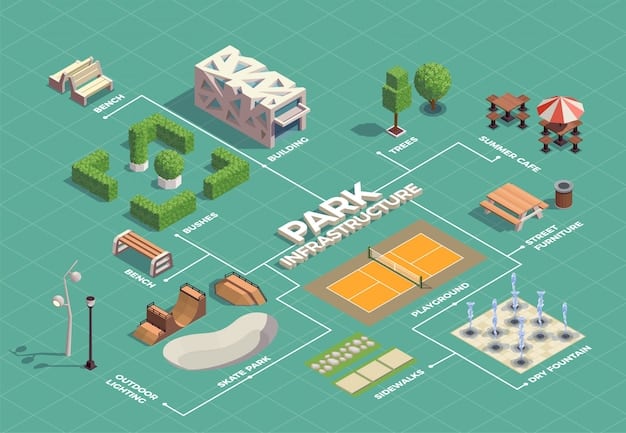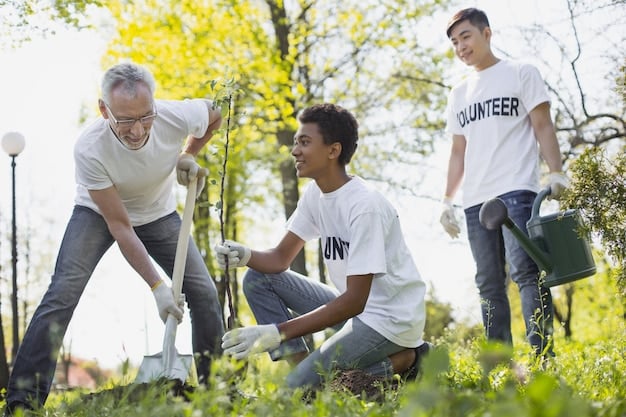Building a Community Playground: Secure Funding & Volunteers

Building a community playground involves strategic fundraising and volunteer recruitment to create a safe, engaging space for children to play and foster community bonds, enhancing neighborhood life and promoting outdoor activity.
Embarking on the journey of building a community playground: a guide to securing funding and volunteers can transform a vacant lot into a vibrant hub for children and families, strengthening community ties and promoting healthy lifestyles.
Planning Your Community Playground
Before hammering the first nail or swinging the first swing, thoughtful planning is essential. It sets the stage for a successful playground build, ensuring that the project meets the community’s needs and stays within budgetary constraints.
Assessing Community Needs
Begin by understanding what the community truly desires and needs. Conduct surveys, hold town hall meetings, and engage local schools and organizations to gather diverse perspectives.
Defining the Scope
Once community input is gathered, clearly define the scope of the project. Determine the size of the playground, the age range of its intended users, and the desired features, such as swings, slides, climbing structures, or accessible play equipment.
- Consider a variety of play elements to cater to different ages and abilities.
- Prioritize safety features like impact-absorbing surfaces and clear sightlines.
- Incorporate natural elements like trees, plants, and landscaping to enhance the play environment.
Solid planning is the cornerstone of any successful community playground project. By thoroughly assessing community needs, defining the scope of the project, and establishing achievable goals, you can lay the foundation for a playground that will be cherished and enjoyed for years to come.

Securing Funding for Your Playground Project
Funding is often the biggest hurdle in bringing a community playground to life. Fortunately, a plethora of avenues exist to secure the necessary financial resources, from grants and sponsorships to community fundraising events.
Exploring Grant Opportunities
Grants are a fantastic source of funding, as they don’t require repayment. Research local, state, and national grant programs dedicated to community development, parks and recreation, and children’s health and well-being.
Seeking Corporate Sponsorships
Engage local businesses and corporations to explore potential sponsorship opportunities. Companies often seek to support community initiatives that align with their values and offer positive brand exposure.
- Craft a compelling sponsorship proposal that clearly outlines the benefits for the sponsor.
- Offer various sponsorship tiers with corresponding recognition levels.
- Recognize sponsors prominently on playground signage, promotional materials, and community events.
Securing funding for a community playground requires a multifaceted approach, combining grant writing, sponsorship outreach, and community fundraising efforts. With dedication and creativity, you can piece together the financial puzzle and turn your playground dreams into a reality.
Recruiting and Managing Volunteers
Volunteers are the lifeblood of any community playground build. Their enthusiasm, skills, and dedication can significantly reduce costs and foster a sense of ownership and pride within the community.
Identifying Volunteer Needs
Before launching a volunteer recruitment campaign, identify the specific tasks that require volunteer assistance. This might include construction, landscaping, fundraising, event planning, and community outreach.
Effective Communication Strategies
Keep volunteers informed and engaged throughout the project by establishing clear communication channels. This might include email newsletters, social media updates, regular meetings, and dedicated communication platforms.
The success of a community playground build hinges on the successful recruitment and management of volunteers. By identifying specific needs, implementing effective communication strategies, and providing proper training and recognition, you can harness the power of volunteerism to create a playground that reflects the spirit of your community.

Choosing the Right Playground Equipment
Selecting playground equipment is a crucial step in creating a safe and engaging play environment. Consider the age range of intended users, the available space, and the overall aesthetic and functional goals of the playground.
Age-Appropriate Considerations
Choose equipment that is specifically designed for the age groups who will be using the playground. Toddlers require different features than older children, so ensure a diverse range of options.
Accessibility and Inclusive Design
Create a playground that is accessible to children of all abilities by incorporating inclusive design principles. This includes ramps, accessible surfacing, and equipment that can be used by children with mobility impairments.
- Consult with accessibility experts and disability advocates to ensure compliance with accessibility standards.
- Incorporate sensory play elements like textured surfaces, musical instruments, and water features.
- Provide quiet spaces for children who may become overwhelmed by sensory stimulation.
Selecting the right playground equipment is a critical decision that impacts the safety, inclusivity, and enjoyment of the play experience. By prioritizing age-appropriateness, accessibility, and safety standards, you can create a playground that is welcoming and engaging for all children in the community.
Navigating Permits and Regulations
Before construction begins, ensure that all necessary permits and approvals are obtained from local government agencies. Compliance with building codes and safety regulations is essential for a successful and safe playground project.
Understanding Local Zoning Laws
Familiarize yourself with local zoning laws and regulations regarding playground construction. This includes setbacks from property lines, height restrictions, and noise ordinances.
Safety Standards Compliance
Ensure that all playground equipment and construction practices comply with relevant safety standards, such as those established by the Consumer Product Safety Commission (CPSC) and the American Society for Testing and Materials (ASTM).
Navigating the landscape of permits and regulations can seem daunting, but it is a necessary step in building a safe and compliant community playground. By diligently researching and adhering to local laws and safety standards, you can ensure a smooth construction process and a playground that meets all necessary requirements.
Celebrating Your Community Playground
The completion of a community playground is a cause for celebration! Organize a grand opening event to showcase the new play space, thank volunteers and donors, and officially welcome the community to enjoy this valuable asset.
Organizing a Grand Opening
Plan a festive grand opening event that includes activities for children, speeches from community leaders, and recognition for volunteers and donors. This is an opportunity to generate excitement and build enthusiasm for the playground.
Ensuring Long-Term Maintenance
Establish a plan for ongoing maintenance and upkeep of the playground to ensure its longevity and safety. This might include regular inspections, repairs, and cleaning, as well as a system for reporting hazards or concerns.
The grand opening of a community playground marks the culmination of countless hours of planning, fundraising, and hard work. By organizing a memorable celebration and establishing a plan for long-term maintenance, you can ensure that the playground remains a source of joy and pride for the community for years to come.
| Key Point | Brief Description |
|---|---|
| ️ Planning Stages | Understand community needs and define project scope early. |
| Fundraising | Explore grants, sponsorships, and community events to secure funds. |
| Volunteers | Recruit, train, and appreciate volunteers effectively. |
| Equipment Choices | Prioritize safety, accessibility, and age-appropriateness in equipment selection. |
Frequently Asked Questions
▼
The first step is to assess the community’s needs and desires. This involves conducting surveys, holding meetings, and gathering input from residents to ensure the playground meets their requirements.
▼
You can secure funding through grants, corporate sponsorships, and community fundraising events. Focus on creating a compelling case for support and engaging local businesses and organizations.
▼
Start by identifying the skills needed for the project. Advertise through local community groups, and social media, highlighting the value of the volunteer effort and showing the results of their involvement in the project.
▼
Choose equipment compliant with safety standards and prioritize inclusive design. Involve accessibility experts. Follow this through inspections, repairs and creating a hazard reporting protocol.
▼
You have to familiarise yourself with zoning as well as construction regulations. Ensure all playground construction is in compliance. Enlisting aid from an attorney or consultant could reduce future violations and help you adhere to regulations.
Conclusion
Building a community playground is a significant endeavor that requires thoughtful planning, dedicated fundraising, effective volunteer recruitment, and a commitment to safety and inclusivity. By following this guide, you can transform a community vision into a vibrant reality, creating a space where children can play, learn, and grow for years to come.





